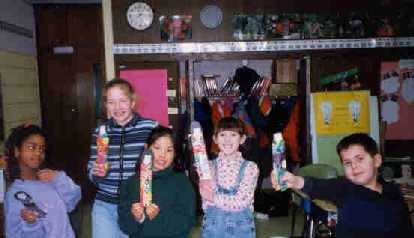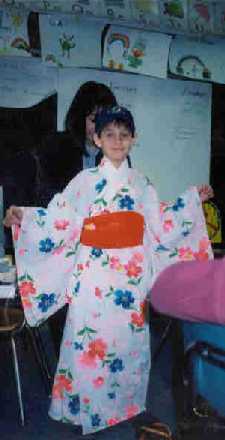Planting Seeds of Friendship |
|
Students enjoy the Japanese The dolls arrived at our school around Hina Doll Festival time in
early March of 1998. One was a traditional doll in a bright crimson kimono,
and the other was a rather big, cute hand-made doll in a simple blue kimono
with a red sash and red ribbon on her head. I was so impressed that they came
with passports with their names. The first doll's name was Kanae, and second one
was Kana, named after the 11-year-old Japanese girl who made the doll with her
mother's help. The long journey of the dolls then began. They were taken to every class, and
the children became good friends with Kana and Kanae. Toshiba International
Foundation has sponsored our Japanese program and some 300 children from K to 3
have been learning about Japan. The program has expanded to other elementary
schools. At Douglas, the first year our theme was Japanese houses, food, and clothes.
In the unit on Japanese clothes, we studied kimono, showing our
Friendship dolls. I put on a kimono and some children put on yukatas
and walked on geta (clogs). The length of a real obi, sash, was a
surprise. I can't forget the way the children said, "Cool!" Another lesson was when the children watched the video The Blue-eyed Dolls.
It tells about the 12,000 American dolls sent to Japan in 1927 and how they were
welcomed and how many survived the war. There is a very touching Japanese song
called "A Blue-eyed Doll" popular around 1910 which we sang together: The children also enjoyed a Japanese-doll making class. We made the project
simple by giving the children a piece of paper cut in half and told them to
design kimono cloth and color it. The children used gold and silver paint
besides regular colors. We cut colored paper in half for the kimono and
collar layers, and used beautiful origami for the obi. Although our
lessons are usually just a half hour, the children were able to assemble their
dolls in time. All the dolls were displayed in the school hallway and what
compliments did we receive from everybody! The happiness and impact the Japanese Friendship dolls have brought to our
school and the community is immeasurable. I would like to say again thank you to
Mukogawa Fort Wright Institute for the dolls and the peace message they brought
to us. Mrs. Takaoka told me in a letter, "How wonderful it is for you to be
able to sow the seeds of friendship in the hearts of 300 children!" |
Reprinted with permission of Yoko Kiser and Mukogawa Fort Wright Institute

 The dolls were introduced at a school assembly. I told the huge audience the
history of the Friendship Doll Program, and that Mukogawa Fort Wright Institute
had resumed the program. It is a very moving story. Then, the whole school
watched me write the dolls' names in Japanese with a big brush and ink. There
was total quiet and total concentration. It was quite a contrast with the uproar
when the dolls were taken out of the boxes and shown to everyone. Teachers of
the school and students oohed and aahed and applauded. Local newspapers wrote
about the dolls' arrival and the message they brought with them, which caused
quite a public response. All the students wrote thank-you letters and drew
pictures of the dolls and sent these to Japan through MFWI in Spokane.
The dolls were introduced at a school assembly. I told the huge audience the
history of the Friendship Doll Program, and that Mukogawa Fort Wright Institute
had resumed the program. It is a very moving story. Then, the whole school
watched me write the dolls' names in Japanese with a big brush and ink. There
was total quiet and total concentration. It was quite a contrast with the uproar
when the dolls were taken out of the boxes and shown to everyone. Teachers of
the school and students oohed and aahed and applauded. Local newspapers wrote
about the dolls' arrival and the message they brought with them, which caused
quite a public response. All the students wrote thank-you letters and drew
pictures of the dolls and sent these to Japan through MFWI in Spokane. We showed our students the video of the Mukogawa Fort Wright Hina Doll
Festival, in which there was a skit done by the Mukogawa students on how Dr.
Gulick started the Friendship Doll Plan, and how it developed.
We showed our students the video of the Mukogawa Fort Wright Hina Doll
Festival, in which there was a skit done by the Mukogawa students on how Dr.
Gulick started the Friendship Doll Plan, and how it developed.